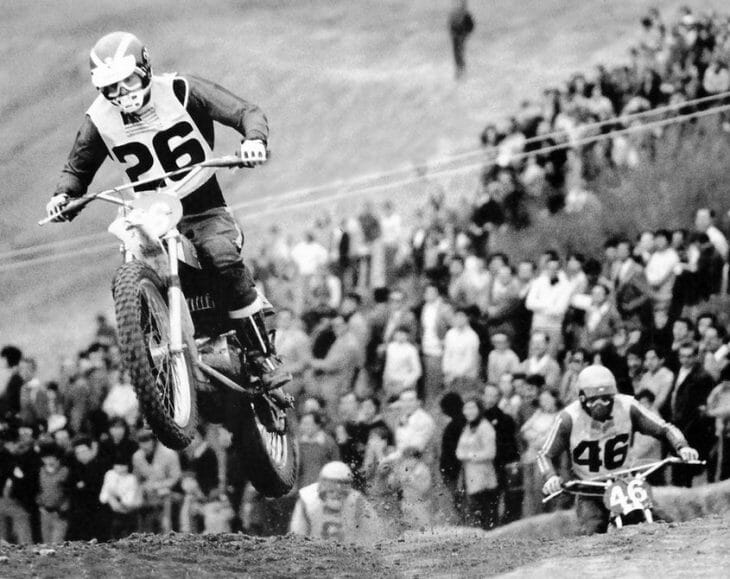Larry Lawrence | February 21, 2018
 Jim Pomeroy (26) was the first America ever to win a World Championship Motocross GP, but he didn’t find out until two days after the race.
Jim Pomeroy (26) was the first America ever to win a World Championship Motocross GP, but he didn’t find out until two days after the race.
Jim Pomeroy was pumped even though he finished second. After all it was his Motocross Grand Prix debut and he’d scored victory in the first moto, much to the delight of the Bultaco faithful on hand that day at the opening round of the 1973 FIM 250cc World Motocross Championship in Sabadell, Spain. Pomeroy watched as German Hans Maisch was handed the winner’s trophy. The only problem was the Spanish racing officials had screwed up. Maisch wasn’t the winner, Pomeroy was! So even though he’d in fact won his debut Grand Prix, Pomeroy did not get to enjoy the accolades of victory. Instead he found out days later that he’d actually won the GP.
How could that happen? More on that later.
Bultaco gave Pomeroy a support deal to race AMA in 1973. Part of the deal was the chance to go and race in Europe before the AMA season started, including the GP in Bultaco’s home country of Spain.
The fact that Pomeroy was getting the opportunity to race in a world championship event in Europe, didn’t draw all that much attention. One of the reasons perhaps, was that by ’73 Bultaco’s motocross machines were not considered to be up to the standards of Yamaha, Kawasaki, Suzuki, Maico, Husqvarna and KTM. The other factor was Pomeroy had only just begun to show promise in 1972 in the American domestic scene by winning the AMA 250cc Motocross National at Saddleback. It was the only national he won that year, so while certainly an up-and-coming rider, Pomeroy was not yet considered among the true elite in American motocross. And now he was off to race in Europe without much fanfare.
Looking back, Pomeroy’s rise in the ranks of motocross racing was rapid to say the least. The rider from Yakima, Washington, grew up in a racing family. His father, Don Pomeroy, was a very successful racer in the late 1950s and ’60s. Motorcycle racing was a family affair for the Pomeroys. Jim, his younger brother Ron, sister Debbie and mother were all involved in motorcycling. Already an accomplished motocross racer in regional events as a teenager, Pomeroy could not race in AMA competition until he was 18, so he headed up to Canada where the age requirement was only 16. He won the Western Canadian Championship, the Manitoba Championship as well as several regional championships.
He became eligible to race AMA and Trans-Am events in 1970, but continued to race mainly regionally in the Pacific Northwest for the next couple of seasons. It was in ’72, on a privateer Bultaco, when Pomeroy began hitting the nationals in earnest and he won almost right off the bat at Saddleback. That victory earned Pomeroy his Bultaco support ride in ’73.

Once in Europe in the spring of ’73, Pomeroy signed up for a couple of International events ahead of the season-opening 250cc MXGP. He did well and his confidence was at an all-time high when the Spanish Grand Prix dawned on April 8, 1973, in Sabadell.
In the first moto Pomeroy got a good start and made the first turn in about fourth. He then worked his way up to the lead on the first lap and held on to take the stunning moto win. Spaniards got behind Pomeroy, rooting for the American rider racing a Spanish-made Bultaco.
In the second moto Pomeroy finished fourth. Maisch, who not only raced for Maico, but his family also owned the company, had taken a 2-3.
This is where things went haywire.
The Spanish officials used the old scoring system, which awarded one point for first, two for second and so on. That left Pomeroy and Maisch tied with five points apiece. The tiebreaker was lowest elapsed time, which gave the win to Maisch. But that year the FIM had in fact, changed the scoring system to award 15 for first, 12 for second, 10 for third and 8 for fourth. Somehow the Spanish officials hadn’t gotten the memo and under the new scoring system Pomeroy took the overall victory with 23 total points to Maisch’s 22.
It was two days after the race when the FIM issued an updated race result showing Pomeroy the true winner.
Bultaco, ecstatic with the victory, immediately signed Pomeroy to contest the rest of the ’73 world championship. He continued to be competitive most of the year, including scoring a second overall at the Italian GP. He finished the season ranked 7th in the final standings. He would go on to win two more MXGPs during his career and would continue racing, including a stint stateside with the factory Honda team, through 1980.
But what about that first-place trophy that Maisch made off with all those years ago in Spain?
Years later a group of friends got together and pitched in and another Spanish 250GP Trophy was obtained from the original foundry in Barcelona. The foundry still had the main component, an original trophy figure left over from 1973. From that another Spanish 250 MXGP trophy was assembled. Then over 30 years later, at the 2003 Chehalis Classic AHRMA National, Pomeroy was presented his 1973 Spanish GP first-place trophy in a surprise ceremony held just before Sunday’s motocross riders meeting.
So eat your heart out Maisch – Jim finally got his trophy after all!